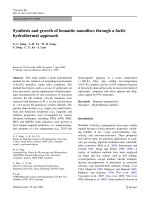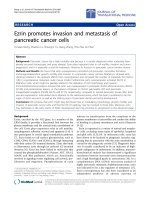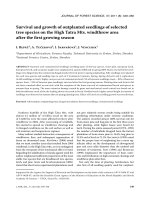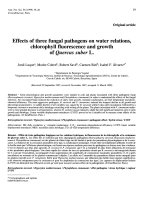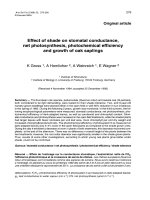Pleiotropically acting MicroRNA 10b regulates angiogenicity, invasion and growth of tumor cells resembling mesenchymal subgroup of glioblastoma multiforme
Bạn đang xem bản rút gọn của tài liệu. Xem và tải ngay bản đầy đủ của tài liệu tại đây (3.67 MB, 123 trang )
- 1 -
Pleiotropically-acting MicroRNA-10b Regulates
Angiogenicity, Invasion and Growth of Tumor Cells
Resembling Mesenchymal Subgroup of Glioblastoma
Multiforme
Lin Jiakai
(B.Sc. (Hons)), NUS
A THESIS SUBMITTED
FOR THE DEGREE OF DOCTOR OF PHILOSOPHY
DEPARTMENT OF BIOLOGICAL SCIENCES
NATIONAL UNIVERSITY OF SINGAPORE
2012
- 2 -
Acknowledgements
The work underlying this thesis was performed at the Institute of
Bioengineering and Nanotechnology. I would like to extend my
gratitude to all who have encouraged me these years. I would like to
thank:
My supervisor A/P Shu Wang, for his expert guidance and
encouragement when times got tough.
Prof Jackie Ying and Ms Noreena, directors of the Institute of
Bioengineering and Nanotechnology, for creating a challenging,
exciting and stimulating working environment and support for my PhD
studies.
My past and present lab mates for being fantastic people to work
around with; Jerome, Jaana, Poonam, Daniel, Keryin, Yukti, Esther,
Xiaoying, Seong Loong, Zhao Ying, Jieming, Chunxiao,
Mohammad, Chrishan, Lam, Yovita, Timothy, Detu, Ghayathri.
My parents for being a strong pillar of support in my life.
My lovely wife, Huiling, and daughter, Rui En, for their unwavering
support over the last few years. I could not have achieved this without
you.
- 3 -
Publication
1. Jiakai Lin, Shi Jia Teo, Jeyaseelan Kandiah, Shu Wang,
MicroRNA-10b Pleiotropically Regulates Angiogenicity, Invasion
and Growth of Tumor Cells Resembling Mesenchymal Subgroup
of Glioblastoma Multiforme, Submitted.
Publication which I have contributed to whose work is not
included in the thesis
1. Chunxiao Wu*, Jiakai Lin*, Michelle Hong, Yukti Choudhury,
Poonam Balani, Doreen Leung, Lam H Dang, Ying Zhao,
Jieming Zeng and Shu Wang, Combinatorial Control of Suicide
Gene Expression by Tissue-specific Promoter and microRNA
Regulation for Cancer Therapy, Molecular Therapy 2009
December; 17(12): 2058–2066. *co-first authors
- 4 -
Table of Contents
Table of Contents 4
Summary 6
List of Tables 7
List of Figures 8
List of Abbreviations 10
Chapter 1: Introduction 13
1.1 Discovery, biogenesis and mechanisms of action of
microRNAs
13
1.2 MicroRNAs in glioblastoma multiforme (GBM) 15
1.3 MicroRNA loss-of-function studies 20
1.3.1 Considerations in microRNA sponge design 26
1.3.2 Advantages and limitations of microRNA sponge 34
1.3.3 Interrogating microRNA function via transient microRNA
sponge expression
37
1.3.4 Interrogating microRNA function via stable microRNA
sponge expression
39
1.3.5 Elucidation of microRNA function in cancer development
40
1.4 Key signaling pathways dysregulated in glioblastoma
multiforme
44
1.4.1 Genetic alterations occurring in the Receptor Tyrosine
Kinase (RTK) pathways
44
1.4.2 Genetic alterations occurring in TP53 tumor suppressor
pathway
46
1.4.3 Genetic alterations occurring in RB1 tumor suppressor
pathway
48
Chapter 2: Aims and objectives 50
Chapter 3: Materials and methods 52
Chapter 4: Results 59
4.1 U87-2M1 is an invasive mesenchymal subline of U87 59
4.2 Inhibition of miR-10b decreases invasiveness of U87-2M1 68
4.3 miR-10b silencing decreases angiogenicity of U87-2M1 71
- 5 -
4.4 Inhibition of miR-10b increases apoptosis of U87-2M1
glioma cells and prolongs survival of U87-2M1-bearing
mice
76
4.5 Pleiotropic miR-10b regulates a broad range of tumor
suppressors
81
4.6 Perturbation of direct and indirect targets of miR-10b
correlates with poorer patient survival
87
Chapter 5: Discussion 90
Chapter 6: Conclusion and future studies 94
Bibliography 96
- 6 -
Summary
Glioblastoma multiforme (GBM) is an extremely heterogeneous
disease despite its seemingly uniform pathology. Deconvolution of The
Cancer Genome Atlas’s GBM gene expression data has unveiled the
existence of distinct gene expression signatures underlying discrete
GBM subgroups. Recent conflicting findings proposed that microRNA-
10b exclusively regulates glioma growth or invasion but not both. We
showed that silencing of microRNA-10b by baculoviral decoy vectors in
a glioma cell line resembling the mesenchymal subgroup of GBM
reduces its growth, invasion and angiogenesis whilst promoting
apoptosis in vitro. In an orthotopic human glioma mouse model,
inhibition of microRNA-10b diminishes the invasiveness, angiogenicity
and growth of mesenchymal glioma cells in the brain and significantly
prolonged survival of glioma-bearing mice. We demonstrated that the
pleiotropic nature of microRNA-10b was due to its suppression of
multiple tumor suppressors including TP53, FOXO3, CYLD, PAX6,
PTCH1 and NOTCH1. By interrogation of the REMBRANDT database,
we noted that dysregulation of many direct targets of microRNA-10b
was associated with significantly poorer patient survival. Thus, our
studies uncovered a novel role for microRNA-10b in regulating
angiogenesis and suggest that microRNA-10b may be a pleiotropic
regulator of gliomagenesis.
- 7 -
List of Tables
Table 1……………………………………………………………. 21
Table 2……………………………………………………………. 43
Table 3……………………………………………………………. 60
Table 4……………………………………………………………. 67
- 8 -
List of Figures
Figure 1. Principle of using microRNA sponge to inhibit
endogenous microRNA function………………………………
25
Figure 2. Design of an expression cassette harboring a
microRNA sponge………………………………………………
28
Figure 3. Illustration of the sequence of a microRNA-10b
binding site ………………………………………………………
32
Figure 4. Genomic sequence alterations and copy number
changes for components of the RTK/Ras/PI(3)K network of
genes ………… ………………………………………………….
46
Figure 5. Genomic sequence alterations and copy number
changes for components of the TP53 network of genes……
47
Figure 6 Genomic sequence alterations and copy number
changes for components of the RB1 network of genes………
49
Figure 7. U87 and U87-2M1 glioma cells were xenografted
intracranially in Balb c/nude mice for three weeks…………….
59
Figure 8. U87-2M1 showed higher endogenous protein
expression of N-cadherin, fibronectin, vimentin, Twist, Stat3,
MMP13, FOXM1, HGF, PLAUR and PLAU compared to U87
cells…………………………………………………………………
61
Figure 9. Quantification of miR-10b expression in glioma cell
lines………………………………………………………………….
62
Figure 10. Construction of control sponge or miR-10 sponge in
baculoviral vectors and the transduction efficiency in U87-2M1
cells……………………………………………………………
63
Figure 11. MicroRNA-10b decoy vector, but not the control
decoy vector, relieves the suppression of luciferase
expression by endogenous miR-10b in U87-2M1 glioma cells.
65
Figure 12. MicroRNA-10b decoy vector decreases the level of
detectable miR-10b in U87-2M1 glioma cells………………….
65
Figure 13. Inhibition of miR-10b in U87-2M1 cells diminishes
its capacity to invade through a transwell membrane coated
with basement membrane matrix………………………………
68
Figure 14. Prior silencing of miR-10b in U87-2M1 cells in vitro
reduces growth of orthotopic tumor with no evident signs of
localized invasion…………………………………………………
69
Figure 15. MicroRNA-10b silencing reduces protein
expression of β-catenin, MMP13, RhoC, PLAUR, PLAU and
HGF and upregulates HOXD10 protein expression……………
70
Figure 16. Over-expression of miR-10b promotes
invasiveness of U87-2M1…………………………………………
71
Figure 17. Inhibition of miR-10b suppresses angiogenesis by
U87-2M1 glioma cells……………………………………………
72
- 9 -
Figure 18. Angiogenic potential of U87-2M1 cells were
determined by an in vitro endothelial cell tube formation
assay…………………………………………………………………
73
Figure 19. MicroRNA-10b likely reduces angiogenic potential
of U87-2M1 by decreasing expression of pro-angiogenic
proteins such as VEGF, IL8, TGFβ2, CTGF and THBS1……
74
Figure 20. A panel of 13 angiogenic genes down-regulated by
miR-10b silencing is frequently over-expressed in the
Mesenchymal subgroup of glioblastoma multiforme (GBM)…
75
Figure 21. MicroRNA-10b silencing promotes apoptosis of
U87-2M1 cells………………………………………………………
76
Figure 22. MTS assay shows a decrease in cell viability after
inhibition of miR-10b……………………………………………….
77
Figure 23. Elevated caspase activity after miR-10b silencing
was detected by the use of a caspase-sensitive Casp-Glo
reagent……………………………………………………………….
77
Figure 24. Western blotting confirms increased protein
expression of cleaved caspase-3 and cleaved caspase-7…….
78
Figure 25. Delivery of miR-10b decoy vector, but not the
control decoy vector, into a subcutaneous U87-2M1 tumor
results in enhanced TUNEL-positive staining…………………
79
Figure 26. Mice bearing U87-2M1 tumors that arose from prior
treatment in vitro with PBS, control decoy vector, or miR-10b
decoy vector showed significantly different survival trends……
80
Figure 27. Predicted miR-10b binding sites in TP53, FOXO3,
PAX6, CYLD, PTCH1 and NOTCH1……………………………
82
Figure 28. Identification of TP53, FOXO3, CYLD, NOTCH1,
PTCH1 and PAX6 as targets of miR-10b………………………
83
Figure 29. Silencing of miR-10b up-regulates target proteins
TP53, FOXO3, CYLD, PTCH1, NOTCH1 and PAX6…………
84
Figure 30. NFkB transcriptional activity is significantly lower in
miR-10b-silenced U87-2M1 cells…………………………………
85
Figure 31. A mechanistic model summarizing the pleiotropic
actions of miR-10b………………………………………………….
87
Figure 32. Perturbed expression of direct targets of miR-10b
are associated with poor patient survival………………………
88
Figure 33. Upregulation of indirect oncogenic targets of miR-
10b significantly correlates with poor patient survival…………
89
- 10 -
List of Abbreviations
AGO Argonaute
AKT Protein kinase B
AMO Anti-miRNA oligonucleotides
AMPK 5' adenosine monophosphate- activated protein
kinase
ANGPT1 Angiopoietin1
ANXA2 Annexin A2
BCL2 B-cell CLL/lymphoma 2
BIM BCL2-like 11 (apoptosis facilitator)
CAB39 Calcium-binding protein 39
CCND1 Cyclin D1
CDK4 Cyclin dependent kinase 4
CDKN2A Cyclin-dependent kinase inhibitor 2A (melanoma,
p16, inhibits CDK4)
CMV Cytomegalovirus
COL1A2 Collagen 1A2
CTGF Connective tissue growth factor
CTNNB1 Catenin (cadherin-associated protein), beta 1
CYLD Cylindromatosis (turban tumor syndrome)
DAVID Database for Annotation, Visualization, and
Integrated Discovery
DVL Dishevelled
E2F1 E2F transcription factor 1
EGFP Enhanced green fluorescent protein
EGFR Epidermal growth factor receptor
ELM Experimental lung metastasis
EMT Epithelial-mesenchymal-transition
ERK Extracellular signal-regulated kinase
EZH2 Enhancer of zeste homolog 2
FN1 Fibronectin1
FOXM1 Forkhead box protein M1
FOXO3 Forkhead box O3
GADD45A Growth arrest and DNA-damage-inducible, alpha
GADD45B Growth arrest and DNA-damage-inducible, beta
GBM Glioblastoma multiforme
GDP Guanosine diphosphate
GTP Guanosine triphosphate
HGF Hepatocyte growth factor
HOXD10 Homeobox D10
HUVEC Human umbilical vein endothelial cells
IKB-Α I-kappa-B-kinase-alpha
IKB-Β I-kappa-B-kinase-beta
IL8 Interleukin 8
ITGA4 Integrin, alpha 4
JAG1 Jagged 1
- 11 -
LAMA4 Laminin, alpha 4
LEPR Leptin receptor
LKB1 Liver kinase B1 or serine/threonine kinase 11
LOX 5-lipoxygenase
LRRC4 Leucine-rich repeat-containing protein 4
LTR Long terminal repeats
MAPK MAP kinase
MARK Microtubule-affinity-regulating kinase
MDM2 Mdm2 p53 binding protein homolog (mouse)
MEK MAP-kinase-kinase-kinase
MIRNA microRNA
MMP13 Matrix metalloproteinase 13
MMP14 Matrix metalloproteinase 14
MMP2 Matrix metalloproteinase 2
MSCV Murine stem cell virus
mTOR Mammalian target of rapamycin
MTS (3-(4,5-dimethylthiazol-2-yl)-5-(3-
carboxymethoxyphenyl)-2-(4-sulfophenyl)-2H-
tetrazolium)
NF1 Neurofibromatosis 1
NFΚB Nuclear factor-kappaB
NOTCH1 Notch homolog 1, translocation-associated
P14 Cyclin-dependent kinase inhibitor 2A (melanoma,
p16, inhibits CDK4), p14 alternative reading frame
P16 Cyclin-dependent kinase inhibitor 2A (melanoma,
p16, inhibits CDK4), p16 INK4a
P21 Cyclin-dependent kinase inhibitor 1A
PAX6 Paired box 6
PDCD4 Programmed cell death 4
PDGFRA Platelet –derived growth factor receptor alpha
PI(3)K Phosphoinositide 3-kinase
PIP2 Phosphatidylinositol-3,4 diphosphate
PIP3 Phosphatidylinositol-3,4,5 triphosphate
PLAU Plasminogen activator, urokinase
PLAUR Plasminogen activator, urokinase receptor
Pre-miRNA Precursor microRNA
Pri-miRNA Primary microRNA
PTCH1 Patched 1
PTEN Phosphatase and tensin homolog
PTPμ Protein tyrosine phosphatase μ
PUMA p53 upregulated modulator of apoptosis
RB1 Retinoblastoma 1
RECK Reversion-inducing-cysteine-rich protein with kazal
motifs
REMBRANDT Repository of Molecular Brain Neoplasia Data
RHOA Ras homolog gene family, member A
RHOC Ras homolog gene family, member C
- 12 -
RISC RNA-induced silencing complex
RTK Receptor tyrosine kinase
SHH Sonic hedgehog
SNAI1 Snail homolog 1 (Drosophila)
SNAI2 Snail homolog 2 (Drosophila)
TCGA The Cancer Genome Atlas
TGFA Transforming growth factor, alpha
TGFB2 Transforming growth factor beta 2
THBS1 Thromobospondin 1
TP53 Tumor protein 53
TUNEL Terminal deoxynucleotidyl transferase dUTP nick
end labeling
TWIST1 Twist homolog 1 (Drosophila)
UTR Untranslated region
VEGF Vascular endothelial growth factor
WNT3A Wingless-type MMTV integration site family,
member 3A
YFP Yellow fluorescent protein
- 13 -
Chapter 1. Introduction
1.1 Discovery, biogenesis and mechanisms of action of
microRNAs
Initial discoveries of microRNAs (miRNA) were made by Ambros and
colleagues who identified lin-4 in C. elegans as a short RNA transcript
with partial sequence complementarity to regions in the 3’ untranslated
region (UTR) of lin-14, thereby regulating LIN-14 protein synthesis (1).
Down-regulation of LIN-14 signals the end of the first larval stage and
progression into the second larval stage. Seven years later, the let-7
miRNA was discovered (2). Akin to lin-4, let-7 has been shown to
regulate developmental timing in C. elegans (2). This groundbreaking
finding accelerated the identification of miRNAs as a class of single-
stranded RNAs of 18-25 nucleotides in length that is prevalent in the
genomes of animals, plants and viruses.
Genomic locations of miRNAs are diverse: they may be found
between genes, within introns or exons, and exist singularly or in
clusters. MicroRNAs are transcribed as part of long precursor RNA
transcripts (primary transcript: pri-miRNA) that fold on themselves to
form hairpin-shaped structures (3). The transcription of pri-miRNA may
be mediated by either polymerase II or polymerase III (4). Each pri-
miRNA may consist of one or more hairpin structures which will
eventually be recognized and cleaved by the Drosha and DGCR8
complex near the base of the stem loop to release precursor miRNA
stem-loops (pre-miRNAs). Pre-miRNAs are exported out of the nucleus
via an exportin-5-dependent process, recognized by ribonuclease III
- 14 -
Dicer and TAR RNA-binding protein and cleaved by Dicer to generate
a mature miRNA duplex (5). Either strand of the duplex may be
biologically active and is incorporated into the RNA-induced silencing
complex (RISC) which contains a member from the Argonaute (Ago)
family of proteins (Ago1, 2, 3 or 4). The miRNA-loaded RISC is able to
recognize target mRNA and consequently resulting in either mRNA
cleavage or translational repression.
The recognition of target mRNAs by miRNAs relies on a rather
ambiguous level of complementarity between the miRNA and its target
site. A minimum requirement for miRNA target recognition appears to
be the existence of base pairing between the seed sequence of the
RISC-loaded miRNA (2
nd
to 7
th
or 8
th
nucleotide from the 5’ end of
miRNA) and its complementary seed sequence in target mRNAs. Base
pairing between the 3’ end of a miRNA and its target site may or may
not be necessary for translational repression to occur. Although
Watson-Crick base-pairing is assumed by most miRNA target
prediction algorithms, numerous miRNAs are known to utilize G:U
wobble pairing in recognizing their targets (6). Full sequence
complementarity between miRNAs and mRNAs are typically
exemplified in plants while partial complementarity between miRNAs
and mRNAs occurs most of the time in animals. While full
complementarity results in mRNA cleavage, partial complementarity is
known to accelerate decay of the mRNA transcripts. This is achieved
by deadenylation, mRNA degradation or interfering with the initiation or
elongation of translation. Messenger RNAs bound to miRNA-loaded
- 15 -
RISC may be localized to cytoplasmic compartments known as P-
bodies where they are sequestered from cytoplasmic translational
machinery or degraded. Moreover, after the initial discovery that
miRNAs recognize complementary sites in the 3’ UTRs of target genes,
miRNAs have also been shown to recognize target sites residing in the
5’ UTR as well as the coding sequence of mRNAs (6). Coupled with
the rather low stringency for functional miRNA and mRNA interactions,
each miRNA can regulate numerous mRNAs.
1.2 MicroRNAs in glioblastoma multiforme (GBM)
Glioblastoma mulitforme (GBM) is an aggressive primary brain tumor
where the median time from clinical diagnosis to mortality is
approximately one year. Since surgical resection, radiotherapy and
chemotherapy provide patients with little improvement to their survival
rates, there is an urgent need to develop new therapeutics with greater
efficacy. Since microRNAs were discovered to regulate gene
expression at the post-transcriptional level, it was not unexpected that
pervasive dysregulation of microRNAs occur during tumorigenesis,
leading to widespread perturbation of many biological processes.
MicroRNAs under-expressed or absent in cancers often target
tumorigenic genes while over-expressed microRNAs target tumor
suppressor genes. Consequently, deregulated gene expression
induced by altered miRNA expression has been shown to influence
several key biological processes affecting tumor progression (7-11),
including motility, invasion, apoptosis, cell growth, angiogenesis and
- 16 -
epithelial-mesenchymal-transition (12). Several miRNAs regulating
gliomagenesis have been identified. A clear understanding of the exact
contributions of microRNA to gliomagenesis will help in developing
therapeutics targeting microRNA expression in GBM.
Expression of glioma-suppressive miRNAs is typically down-
regulated in GBM; re-expression of such miRNAs in gliomas presents a
therapeutic opportunity. Consequences of microRNA expression
therapy are often very similar, glioma cells may undergo cell cycle
arrest, apoptosis, differentiation or diminished invasiveness and
angiogenicity. MicroRNA-7 is one such miRNA whose re-expression
decreases the survival, proliferation and invasiveness of cultured
glioma cells (13). MiR-7 is known to target EGFR, an oncogenic
receptor tyrosine kinase that is frequently amplified in GBM (13) and
focal adhesion kinase, which regulates glioma cell invasion (14).
Delivery of miR-31 into glioma cells down-regulates radixin and inhibits
glioma cell migration and invasion (15). MiR-451 inhibits the PI3K/AKT
pathway via targeting CAB39 (16), hence reducing glioma growth,
proliferation, and invasion whilst promoting apoptosis (16, 17). In
particular, miR-451 expression varies correspondingly with glucose
levels (18). Under low glucose conditions, miR-451 expression
decreases such that it no longer represses CAB39 thus stabilizing the
LKB1 complex and phosphorylation of AMPK. This reduced
proliferation through inhibition of mTOR but increased cell migration
through phosphorylation of MARK. This adaptation is perceived to let
glioma cells compromise cell proliferation in favor of more aggressive
- 17 -
invasion that will ameliorate the metabolic stress facing the glioma cells
(18). Expression of miR-205 in glioma cells induces cell cycle arrest,
apoptosis, viability and invasiveness. Furthermore, miR-205 targets
VEGF-A, implying that miR-205 acts pleiotropically in suppressing
gliomagenesis by regulating angiogenesis(19). MiR-124 and miR-137
are highly expressed in normal brain tissues and their introduction into
cultured glioma cells reduced cellular proliferation and induced
neuronal differentiation (20). Similar to miR-124, pro-neuronal miR-128
miR-128 represses growth of glioma-initiating neural stem cells via
targeting the epithelial growth factor receptor (EGFR) and platelet-
derived growth factor receptor alpha (PDGFRA) (21). In addition to
miR-7 and miR-128, miR-146b-5p similarly targets EGFR and miR-
146b-5p expression suppresses glioma cell invasion, migration and
phosphorylation of Akt (22). MiR-106a suppresses proliferation and
induces apoptosis in glioma cells via targeting E2F1 in a p53-
independent fashion (23). miR-101 is down-regulated in GBM and
targets the histone methyltransferase EZH2 (24). Expression of miR-
101 in glioma cells in vitro attenuated glioma cell growth, migration,
invasion and GBM-induced endothelial tubule formation (24). miR-26b
is lowly expressed in glioma cells and re-expression of miR-26b
diminished proliferation, migration and invasion of glioma cells in vitro
(25). Moreover, miR-26b targets ephrin A2 and diminish the capacity of
glioma cells in forming microvascular channels in vasculogenic mimicry
experiments (25). Re-expression of miR-218 suppresses the invasive
potential of gliomas, a process mediated by mir-218’s down-regulation
- 18 -
of its target protein, IKK-β, an antagonist of NF-κB activation (26). miR-
29b and miR-125a are down-regulated in GBM and their re-expression
in glioma cells coordinately down-regulate podoplanin and
consequently inhibit invasion, apoptosis and proliferation of glioma
cells (27). Although numerous miRNA targets for miRNA replacement
therapy in GBM have been identified, the hurdles facing systemic
delivery of RNA oligonucleotides to glioma tissues remain – how
should RNA oligonucleotides such as miRNA or siRNA be delivered to
achieve maximum efficacy with minimum systemic toxicity.
As opposed to tumor-suppressive miRNAs, oncogenic miRNAs
target an assortment of tumor suppressor genes that normally limit
tumor cell growth, angiogenesis and motility. MicroRNA-221 has been
shown to be over-expressed in GBM and targets tumor suppressor p27
(28, 29) as well as pro-apoptotic PUMA (30). Moreover, miR-221 and
miR-222 targets protein tyrosine phosphatase µ (PTPµ) which
suppresses glioma cell migration and dispersal (31). miR-26a is
frequently amplified in GBM at the genomic level and this amplification
is often associated with monoallelic PTEN loss, a result of functional
regulation of PTEN by miR-26a (32). miR-335 expression is highly
elevated in astrocytomas and ectopic expression of miR-335 in C6 rat
glioma cells enhances its viability, soft-agar colony forming ability and
invasiveness (33). Silencing of miR-335 causes growth arrest and
apoptosis as well as reduced invasion and reduced growth of
xenografts (33). miR-381 is another candidate oncogenic miRNA that
targets glioma suppressor LRRC4 (34). Suppressed LRRC4
- 19 -
expression enhances glioma cell proliferation in vitro and in vivo via
decreased inhibition of MEK/ERK and AKT signaling (34). Ectopic
expressing of miR-93 in U87 glioma cells augmented co-cultured
endothelial cell spreading, growth and tube formation in vitro and
promoted blood vessel formation in vivo (35). Furthermore, integrin-β8
is a target of miR-93 and the silencing of integrin- β8 by miR-93
enhanced glioma cell proliferation (35). miR-21 is broadly over-
expressed in many tumors including GBM (36) and its regulation of
tumor cell motility, invasion and apoptosis have been vastly
demonstrated (37-40). Down-regulation of miR-21 or over-expression
of its target, programmed cell death 4 (PDCD4), decreased
proliferation and increased apoptosis in cultured glioma cells (41). High
expression of miR-21 also causes glioma invasion via down-regulating
Sprouty2 and interference of the Ras/MAPK negative feedback circuit
(42). Furthermore, silencing of miR-21 in cultured glioma cells led to
reduced viability in murine xenografts (38, 41). Over-expression of
miR-30e* down-regulates IκBα, leading to hyperactivation of NF-κB
and NF-κB-regulated genes (43). Hyperactivation of NF-κB pathway
increases the invasiveness of glioma cells.
A key trait of many systemic cancers is the ability to acquire the
metastatic phenotype and colonizes distant organs away from the
primary tumor site. MicroRNA-10b was first suggested as a pro-
metastasis miRNA via its down-regulation of HOXD10 in metastatic
breast cancer (44); miR-10b is coincidentally the most highly over-
expressed miRNA in GBM (32, 45) even though GBM rarely
- 20 -
metastasizes out of the brain. Recent reports on the contributions of
miR-10b to gliomagenesis, however, present conflicting findings.
Gabriely and co-workers showed that miR-10b promotes glioma cell
growth and suppresses cell death with no effects on glioma cell
invasion (46), while Sun and co-workers demonstrated miR-10b does
not affect glioma cell cycle but enhances glioma cell invasion via down-
regulation of HOXD10 and up-regulation of MMP14 and PLAUR (47).
Further studies are needed to clarify the actual contribution of miR-10b
to gliomagenesis. Various tools and techniques for silencing miRNA
exist and the strengths and weakness of each approach will be
discussed.
1.3 MicroRNA Loss-of-Function Studies
Adding to the complexity in miRNA studies is the perception that each
miRNA can possibly regulate hundreds of target genes, a fact
underscored by numerous published miRNA-target prediction
algorithms (6, 48-50) that have aided miRNA target identification.
However, every computational prediction of a miRNA target has to be
experimentally validated, thus complicating efforts in the functional
annotation of more than 1000 animal miRNAs known thus far. Given
the existing scientific interest in differential gene expression in various
biological contexts, the discovery of miRNAs led to an onslaught of
studies that implicated miRNAs in physiological responses,
developmental processes and disease development. Therefore,
studies of any miRNA have to be performed in the context that it is
- 21 -
expressed in, to provide a factual mechanistic understanding of a
miRNA’s biological contribution. Cognizant of the fact that a gene’s
physiological expression level affects its function and activity, a loss-of-
function experimental approach allows for biologically-relevant
discoveries of a miRNA’s function. In contrast, stemming from the
observation that interactions between miRNA and target mRNA are
strongly concentration-dependent, non-physiological mRNA targets
may be repressed when exogenous miRNA is added at
supraphysiological levels to a cellular system (51).
Four strategies for studying miRNA loss-of-function exist: Dicer
inactivation technology (52), genetic knockouts (53), anti-miRNA
oligonucleotides (54, 55) and miRNA sponge or decoy technology (53,
56-59). A quick summary of the pros and cons of each technology is
summarized in Table 1.
Table 1. Comparison of current microRNA inhibition technologies
Inactivation of
MicroRNA
Processing
Machinery
(e.g. Dicer)
Genetic
Knockouts
Anti-
microRNA
Oligo-
nucleotides
MicroRNA
Sponge
Specificity for
single miRNA
Poor Very high Very high High
Ease of
targeting entire
family of
miRNAs
Impossible Tedious Easy Very easy
Ease of
implementation
Tedious Tedious Very easy Very easy
Potential for
therapeutic use
Unlikely No Possible Possible
- 22 -
Dicer is an integral part of the miRNA biogenesis pathway and
has been a popular target for studies on global loss of miRNA function.
Dicer inactivation allows scientists to define the requirement of miRNAs
at the cell, tissue or system level. Various groups have utilized the
Dicer inactivation technology to conclude that miRNAs are necessary
and important for cell lineage decisions (60), lung development (61),
lymphocyte development (62-64). Certain important caveats have to be
considered in the use of this approach. One, inactivation of Dicer does
not allow for the identification of the miRNA that are involved in any
biological process being studied. Two, knocking out Dicer often leads
to embryonic lethality or early neonatal death (65-68). Three, Dicer
inactivation in the adult heart unexpectedly resulted in an increased
expression of a subset of microRNAs, putting the effectiveness of Dicer
inactivation into question (69).
On the other hand, genetic knockouts provide a powerful tool for
a permanent, complete loss-of-function analysis of any microRNA both
in situ at a cellular level and in a tissue-specific manner in vivo. Gene
knockout technologies are at a mature state of development, with the
homologous recombination method mostly used in miRNA knockout
mice (70, 71) and the FLP-FRT deletion method in flies (72, 73).
MicroRNA knockouts have so far been used to study the function of
Drosophila miR-1 (72, 73), murine miR-1-2 (71), murine miR-126 (74)
and murine miR-155 (70). Evidently, gene ablations in animals are
largely limited to flies (72, 73) and rodents (70, 71) and impossible for
studies in humans. As a knockout phenotype is influenced by
- 23 -
environmental and genetic factors and given some existing differences
between the physiology of flies, mice and humans, it may not be easy
to extrapolate findings from model organisms to humans. Another
challenge lies in the residence of many miRNAs in protein-coding
genes (75), hence obstructing efforts at creating clean genetic
knockouts without creating confounding factors. An obvious
disadvantage of the miRNA knockout approach is that some miRNAs
belong to a family of closely related miRNAs. MicroRNA members in a
family have the same seed sequence and are hence predicted to target
a similar repertoire of mRNA targets; this mechanism of redundancy
greatly diminishes any meaningful phenotypic discovery. In many
cases, members of a miRNA family are located at different genomic
loci, making the genetic knockout of the entire miRNA family a
complicated, if not impossible task.
Anti-miRNA oligonucleotides (AMOs) are antisense
oligonucleotides which are fully complementary to the sequence of the
miRNA being studied. AMOs may require certain chemical
modifications to enhance hybridization stability by rendering them (i)
resistant to cellular nucleases, (ii) resistant to cleavage after miRNA
binding and (iii) highly effective in binding miRNA and out-competing
endogenous mRNAs in binding to miRNA. Such chemical modifications
include 2’-O-methyl ribose sugars (54, 55, 76), 2’-deoxynucleotides
and locked nucleic acid nucleotides (39, 77-79), phosphorothioate
backbone linkages (80-83) and peptide nucleic acid oligonucleotides
(84). AMOs delivered into cells base pair efficiently with the mature
- 24 -
miRNA in the RISC complex, thus mediating a potent miRNA-specific
loss-of-function. AMOs eventually do get degraded over time, hence an
AMO-mediated loss of miRNA function can only be a transient event
and provides a window of opportunity for scientists to identify miRNA
targets that are derepressed. Frequently, AMO-mediated inhibition of
miRNA function arise from a degradation of the target miRNA (80, 83,
85) although in a few reports, AMOs have been found to sequester
their target miRNAs without causing their degradation (86, 87). A few
studies that quantified miRNA expression after AMO-mediated miRNA
silencing found that an AMO can achieve almost full knockdown of its
targeted miRNA (43-46). Due to the ease of design, production and
commercial availability, AMOs have turned out to be a favorite tool of
researchers. In particular, AMOs do not discriminate between identical
mature miRNAs that may have arose from different genomic loci,
hence offering an easy mode of knocking down miRNAs with multiple
genomic copies.
The miRNA sponge technology relies on the transcription of an
mRNA containing several tandem target sites complementary to a
miRNA of interest. High over-expression of the miRNA sponge favors
its binding to the miRNA of interest, thereby hindering the miRNA’s
ability to regulate its natural target mRNAs. A simple illustration of the
technology is shown in Figure 1.
- 25 -
Figure 1. Principle of using microRNA sponge to inhibit endogenous
microRNA function. In the absence of a microRNA sponge (left),
microRNA-loaded RNA-induced silencing complex (RISC) recognizes
target mRNAs in the cell. Numerous copies of microRNA sponge in the
cell (right) their binding to the target microRNA and decreases the
probability of microRNA binding to endogenous mRNA targets.
Translational repression exerted by the microRNA on its endogenous
target mRNAs is relieved.
The miRNA sponge technology is especially well suited for
knocking down closely related members of a miRNA family due to their
sharing of a seed sequence (typically between nucleotides 2-8 of the
mature miRNA) with one or more differing nucleotides in the remaining
miRNA sequence (88-90). We shall discuss the key considerations in
designing an effective miRNA sponge for miRNA interference in the
next section. It is intriguing to note that miRNA sponges, although
thought to be entirely synthetic when it was first devised in 2007, are
present naturally in both plants (91, 92) and animals (93) and
represents a novel miRNA regulatory mechanism.
